Last Updated 1 month ago
Ganesh Temples in India – Ganesh temples are dedicated to Lord Ganesh, the elephant-headed Hindu deity who is widely revered as the remover of obstacles, the patron of arts and sciences, and the god of wisdom and intellect. These temples can be found in various parts of India, and each temple has its own unique significance, history, and cultural importance. Here are some key aspects of Ganesh temples in India:
- Significance – Ganesh temples hold immense significance for devotees who seek blessings for success, prosperity, and the removal of obstacles in their lives. Lord Ganesh is worshipped at the beginning of any auspicious occasion or venture as per Hindu tradition.
- Architecture – Ganesh temples come in various architectural styles, ranging from ancient stone structures to modern-day architectural marvels. Some temples are simple in design, while others are elaborate with intricate carvings and sculptures depicting stories from Hindu mythology.
- Popular Temples – Some of the most famous Ganesh temples in India include the Siddhivinayak Temple in Mumbai, Maharashtra; Dagadusheth Halwai Ganapati Temple in Pune, Maharashtra; and the Ashtavinayak Temples, a group of eight temples dedicated to Lord Ganesh in Maharashtra.
- Ashtavinayak Temples – These are a group of eight ancient temples dedicated to Lord Ganesh, located in the Indian state of Maharashtra. Each temple has its own unique legend and significance, and devotees undertake pilgrimages to visit all eight temples for blessings and fulfillment of wishes.
- Festivals and Celebrations – Ganesh Chaturthi, also known as Vinayaka Chaturthi, is the primary festival dedicated to Lord Ganesh and is celebrated with great fervor across India, especially in Maharashtra. During this festival, elaborate processions, cultural events, and rituals are held, culminating in the immersion of Ganesh idols in water bodies.
- Pilgrimage Sites – Many Ganesh temples are situated in scenic locations or amidst natural beauty, making them popular pilgrimage sites for devotees. These temples often attract tourists and visitors who seek spiritual solace and divine blessings.
- Local Customs and Traditions – Each Ganesh temple may have its own set of customs, rituals, and traditions followed by devotees. These may include offerings of sweets, fruits, and flowers to Lord Ganesh, as well as special prayers and ceremonies conducted by priests and worshippers.
Overall, Ganesh temples in India are not only places of worship but also cultural landmarks that reflect the deep-rooted devotion and reverence for Lord Ganesh among millions of devotees across the country.

List of 15 Renowned Ganesh Temples in India
Siddhivinayak Temple, Mumbai, Maharashtra
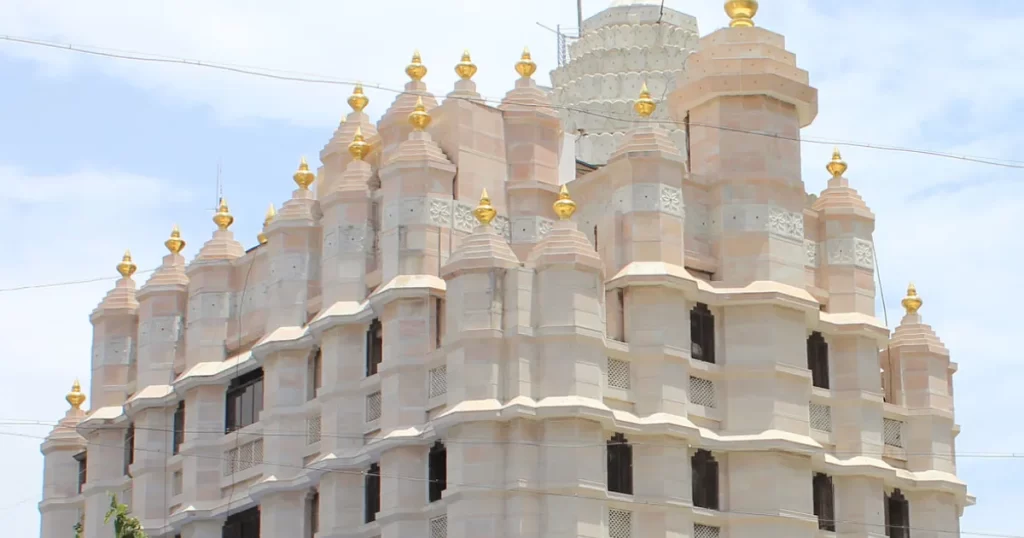
The Siddhivinayak Temple is one of the most famous and revered Hindu temples dedicated to Lord Ganesh, located in Mumbai, Maharashtra, India. In the race for the top 15 ancient Ganesh temples in India 2025, Siddhivinayak Temple stands at the 1st position. Here is an overview of the Siddhivinayak Temple:
- Location – The Siddhivinayak Temple is situated in the Prabhadevi area of Mumbai, Maharashtra. It is strategically located and easily accessible from different parts of the city.
- History – The temple was originally built in the year 1801 by a Hindu woman named Deubai Patil and her husband, Laxman Vithu, who were devotees of Lord Ganesh. Over the years, the temple underwent renovations and expansions to accommodate the growing number of devotees.
- Deity – The presiding deity of the Siddhivinayak Temple is Lord Ganesh, also known as Siddhivinayak, which means “the bestower of wishes and success.” The idol of Lord Ganesh is made of black stone and is two and a half feet tall with the trunk to the right.
- Architecture – The temple’s architecture is a blend of traditional Hindu temple architecture and modern design elements. The sanctum sanctorum (garbhagriha) of the temple is adorned with intricate carvings and sculptures depicting various forms of Lord Ganesh.
- Significance – The Siddhivinayak Temple is considered one of the most auspicious and powerful temples dedicated to Lord Ganesh. Devotees from all walks of life visit the temple to seek the blessings of Lord Ganesh for success, prosperity, and the removal of obstacles.
- Festivals – The temple celebrates various festivals dedicated to Lord Ganesh, with Ganesh Chaturthi being the most prominent. During this festival, which usually falls in the month of August or September, the temple is adorned with decorations, and elaborate rituals and ceremonies are conducted.
- Visitor Information – The Siddhivinayak Temple is open to devotees and visitors throughout the year. The temple receives a large number of devotees, especially on Tuesdays, which is considered an auspicious day for worshipping Lord Ganesh.
- Facilities – The temple complex is well-maintained and equipped with facilities for devotees, including queue management systems, restrooms, and facilities for offerings and donations.
Overall, the Siddhivinayak Temple holds immense spiritual significance for devotees of Lord Ganesh and is a symbol of faith, devotion, and divine blessings in Mumbai and beyond. It stands as a testament to the deep-rooted cultural and religious heritage of Maharashtra.
Dagadusheth Halwai Ganapati Temple, Pune, Maharashtra
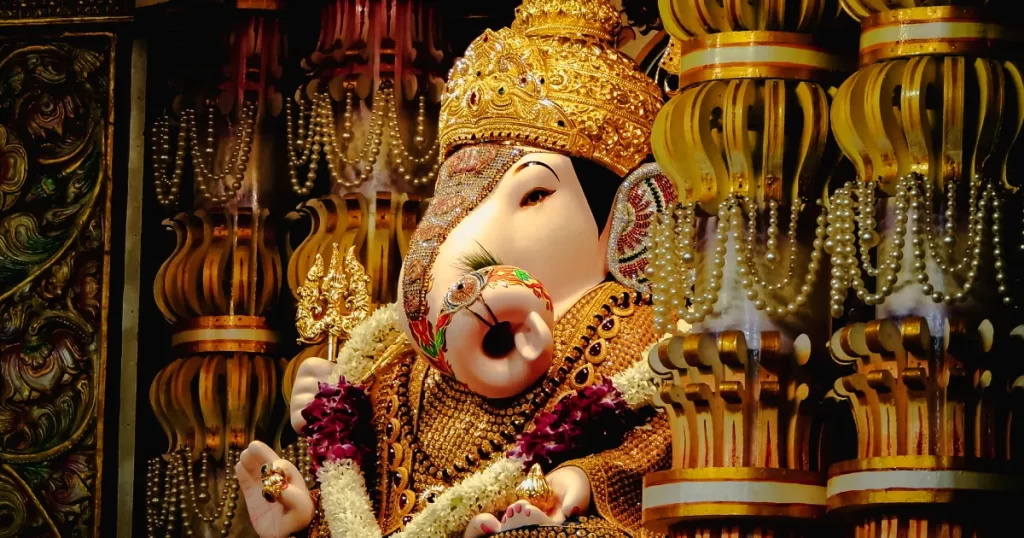
The Dagadusheth Halwai Ganapati Temple is one of the most famous and revered Hindu temples dedicated to Lord Ganesh, located in Pune, Maharashtra, India. In the race for the top 15 ancient Ganesh temples in India 2025, Dagadusheth Halwai Ganapati Temple stands at the 2nd position. Here is an overview of the Dagadusheth Halwai Ganapati Temple:
- Location – The Dagadusheth Halwai Ganapati Temple is situated in the heart of Pune city, in the bustling area of Budhwar Peth. It is easily accessible from various parts of Pune and is a prominent landmark in the city.
- History – The temple was established in the late 19th century by a wealthy sweetmeat seller named Dagadusheth Halwai and his wife, Lakshmibai. It was built as a dedication to Lord Ganesh after the couple experienced a personal tragedy. The temple has since become a symbol of devotion and faith for millions of devotees.
- Deity – The presiding deity of the Dagadusheth Halwai Ganapati Temple is Lord Ganesh, also known as Dagadusheth Ganapati. The idol of Lord Ganesh is made of gold and is adorned with precious jewels. It is seated on a throne and is depicted with four arms holding various symbolic objects.
- Architecture – The temple’s architecture is a blend of traditional Marathi temple architecture and modern design elements. The sanctum sanctorum (garbhagriha) of the temple is adorned with intricate carvings and sculptures depicting various forms of Lord Ganesh.
- Significance – The Dagadusheth Halwai Ganapati Temple is considered one of the most important and powerful temples dedicated to Lord Ganesh in Maharashtra. Devotees from all walks of life visit the temple to seek the blessings of Lord Ganesh for success, prosperity, and the removal of obstacles.
- Festivals – The temple celebrates various festivals dedicated to Lord Ganesh, with Ganesh Chaturthi being the most prominent. During this festival, which usually falls in the month of August or September, the temple is adorned with decorations, and elaborate rituals and ceremonies are conducted.
- Social Initiatives – The Dagadusheth Halwai Ganapati Temple is also known for its philanthropic activities and social initiatives. The temple trust is involved in various charitable works, including providing aid to the underprivileged, supporting education, and organizing community welfare programs.
- Visitor Information – The Dagadusheth Halwai Ganapati Temple is open to devotees and visitors throughout the year. The temple receives a large number of devotees, especially during festivals and auspicious occasions.
Overall, the Dagadusheth Halwai Ganapati Temple is a symbol of faith, devotion, and divine blessings in Pune and beyond. It serves as a spiritual and cultural hub for devotees of Lord Ganesh and stands as a testament to the rich heritage of Maharashtra.
Ashtavinayak Temples (Eight Temples Dedicated to Lord Ganesh), Maharashtra

The Ashtavinayak Temples are a group of eight ancient Hindu temples dedicated to Lord Ganesh, located in the Indian state of Maharashtra. These temples are considered highly sacred by devotees and are visited as part of a pilgrimage circuit known as the Ashtavinayak Yatra.
In the race for the top 15 ancient Ganesh temples in India 2025, All Ashtavinayak Temples stands at the 3rd position. Here is an overview of the Ashtavinayak Temples:
- Significance – The Ashtavinayak Temples are dedicated to Lord Ganesh, the elephant-headed Hindu deity who is widely revered as the remover of obstacles and the god of wisdom and intellect. Each of the eight temples is believed to house a unique idol of Lord Ganesh, and devotees undertake pilgrimages to visit all eight temples for blessings and fulfillment of wishes.
- Location – The Ashtavinayak Temples are scattered across various regions of Maharashtra, covering a distance of approximately 290 kilometers. The temples are located in the following places:
- Moreshwar Temple in Morgaon
- Siddhivinayak Temple in Siddhatek
- Ballaleshwar Temple in Pali
- Varadvinayak Temple in Mahad
- Chintamani Temple in Theur
- Girijatmaj Temple in Lenyadri
- Vighnahar Temple in Ozar
- Mahaganapati Temple in Ranjangaon
- Legends and Stories – Each of the Ashtavinayak Temples is associated with a unique legend or story from Hindu mythology. These stories narrate the origin of the temple, the significance of the idol, and the miracles attributed to Lord Ganesh. Devotees often recite these stories and perform rituals and prayers at each temple as part of the pilgrimage.
- Architecture – The temples exhibit a blend of architectural styles, reflecting the rich heritage and cultural diversity of Maharashtra. Some temples are ancient stone structures with intricate carvings and sculptures, while others have been renovated and embellished with modern amenities.
- Pilgrimage Circuit – The Ashtavinayak Yatra is a popular pilgrimage circuit that covers all eight temples in a specific sequence, starting and ending at Morgaon. Devotees embark on this pilgrimage to seek the blessings of Lord Ganesh, offer prayers, and perform rituals for the fulfillment of their desires and wishes.
- Festivals and Celebrations – The Ashtavinayak Temples celebrate various festivals dedicated to Lord Ganesh, with Ganesh Chaturthi being the most prominent. During this festival, elaborate processions, cultural events, and rituals are held at each temple, attracting thousands of devotees from different parts of Maharashtra and beyond.
Overall, the Ashtavinayak Temples are not only places of worship but also cultural landmarks that reflect the deep-rooted devotion and reverence for Lord Ganesh among millions of devotees in Maharashtra. The Ashtavinayak Yatra is considered a sacred journey of faith and spiritual awakening for devotees seeking the blessings of Lord Ganesh.
Shree Mahaganapathi Temple, Gokarna, Karnataka
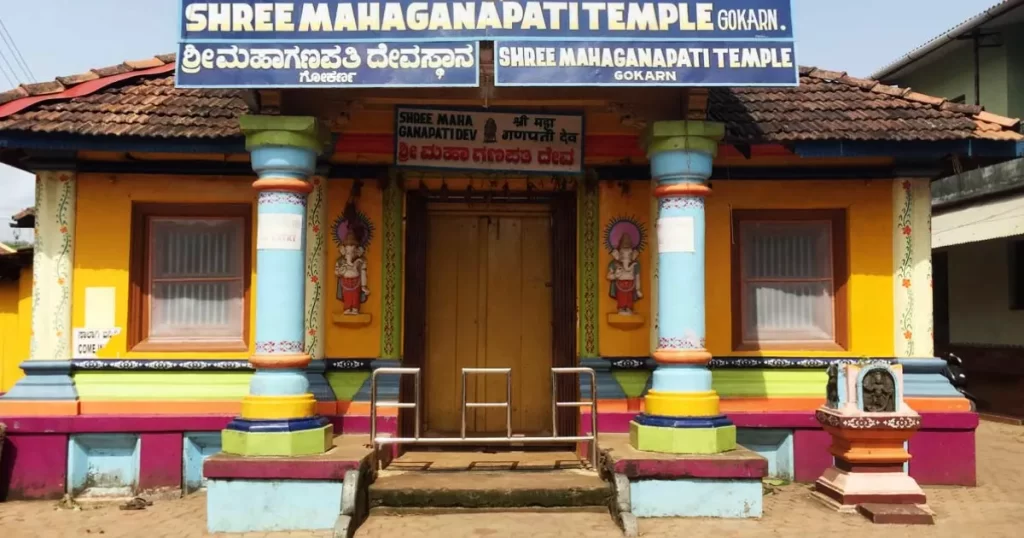
The Shree Mahaganapathi Temple is a revered Hindu temple dedicated to Lord Ganesh, located in Gokarna, Karnataka, India. In the race for the top 15 ancient Ganesh temples in India 2025, Shree Mahaganapathi Temple stands at the 4th position. Here is an overview of the Shree Mahaganapathi Temple:
- Location – The Shree Mahaganapathi Temple is situated in the town of Gokarna, a renowned pilgrimage destination located in the Uttara Kannada district of Karnataka. Gokarna is known for its scenic beauty, pristine beaches, and religious significance.
- History – The exact origins of the Shree Mahaganapathi Temple are not well-documented. However, it is believed to be one of the ancient temples in Gokarna, which is considered a sacred site associated with Hindu mythology and the legend of Lord Shiva.
- Deity – The presiding deity of the Shree Mahaganapathi Temple is Lord Ganesh, also known as Mahaganapathi, the supreme lord of obstacles. The idol of Lord Ganesh is enshrined within the sanctum sanctorum (garbhagriha) of the temple and is worshipped with great reverence by devotees.
- Architecture – The temple’s architecture reflects traditional South Indian temple architecture, characterized by intricate carvings, ornate pillars, and towering gopurams (entrance towers). The main sanctum of the temple is adorned with sculptures depicting various forms of Lord Ganesh.
- Significance – The Shree Mahaganapathi Temple holds immense significance for devotees who seek the blessings of Lord Ganesh for success, prosperity, and the removal of obstacles. It is believed that worshipping Lord Ganesh at this temple can help devotees overcome challenges and achieve their goals.
- Rituals and Worship – The temple conducts regular rituals and prayers dedicated to Lord Ganesh, including elaborate poojas (worship ceremonies), abhishekams (ritualistic bathing), and aratis (offerings of light). Devotees offer prayers, flowers, coconuts, and other offerings to the deity as a mark of their devotion.
- Festivals – The Shree Mahaganapathi Temple celebrates various festivals dedicated to Lord Ganesh, with Ganesh Chaturthi being the most prominent. During this festival, which usually falls in the month of August or September, the temple is adorned with decorations, and elaborate rituals and ceremonies are conducted.
- Visitor Information – The Shree Mahaganapathi Temple is open to devotees and visitors throughout the year. It is a popular pilgrimage destination in Gokarna and attracts devotees from different parts of Karnataka and beyond.
Overall, the Shree Mahaganapathi Temple is a sacred place of worship and a symbol of faith and devotion in Gokarna. It stands as a testament to the rich cultural and religious heritage of Karnataka and continues to be a source of spiritual solace for devotees seeking the blessings of Lord Ganesh.
Karpaka Vinayakar Temple, Pillayarpatti, Tamil Nadu
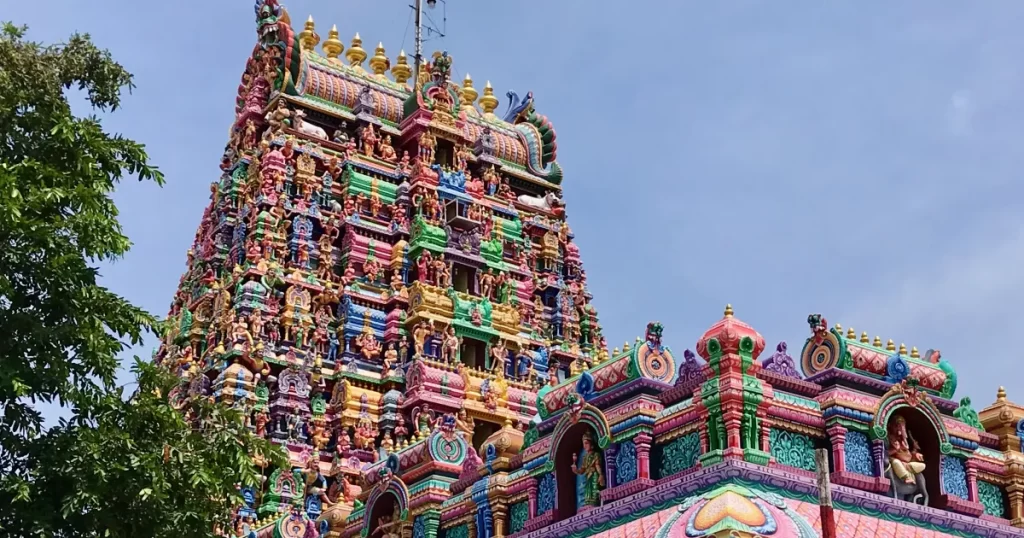
The Karpaka Vinayakar Temple is a renowned Hindu temple dedicated to Lord Ganesh, located in Pillayarpatti, Tamil Nadu, India. In the race for the top 15 ancient Ganesh temples in India 2025, The Karpaka Vinayakar Temple stands at the 5th position. Here is an overview of the Karpaka Vinayakar Temple:
- Location – The Karpaka Vinayakar Temple is situated in the village of Pillayarpatti, which is located in the Sivaganga district of Tamil Nadu. The temple is approximately 12 kilometers from Karaikudi and is easily accessible by road.
- History – The exact origins of the Karpaka Vinayakar Temple are not well-documented. However, it is believed to have been built during the Pandyan dynasty, making it one of the ancient temples in the region. The temple is renowned for its historical significance and architectural beauty.
- Deity – The presiding deity of the Karpaka Vinayakar Temple is Lord Ganesh, also known as Karpaka Vinayakar. The idol of Lord Ganesh is enshrined within the sanctum sanctorum (garbhagriha) of the temple and is worshipped with great reverence by devotees.
- Architecture – The temple’s architecture reflects traditional South Indian temple architecture, characterized by intricate carvings, ornate pillars, and towering gopurams (entrance towers). The main sanctum of the temple is adorned with sculptures depicting various forms of Lord Ganesh.
- Significance – The Karpaka Vinayakar Temple holds immense significance for devotees who seek the blessings of Lord Ganesh for success, prosperity, and the removal of obstacles. It is believed that worshipping Lord Ganesh at this temple can help devotees overcome challenges and achieve their goals.
- Rituals and Worship – The temple conducts regular rituals and prayers dedicated to Lord Ganesh, including elaborate poojas (worship ceremonies), abhishekams (ritualistic bathing), and aratis (offerings of light). Devotees offer prayers, flowers, coconuts, and other offerings to the deity as a mark of their devotion.
- Festivals – The Karpaka Vinayakar Temple celebrates various festivals dedicated to Lord Ganesh, with Vinayaka Chaturthi being the most prominent. During this festival, which usually falls in the month of August or September, the temple is adorned with decorations, and elaborate rituals and ceremonies are conducted.
- Visitor Information – The Karpaka Vinayakar Temple is open to devotees and visitors throughout the year. It is a popular pilgrimage destination in Tamil Nadu and attracts devotees from different parts of the state and beyond.
Overall, the Karpaka Vinayakar Temple is a sacred place of worship and a symbol of faith and devotion in Pillayarpatti and Tamil Nadu. It stands as a testament to the rich cultural and religious heritage of the region and continues to be a source of spiritual solace for devotees seeking the blessings of Lord Ganesh.
Uchi Pillayar Temple, Rockfort, Tiruchirapalli, Tamil Nadu
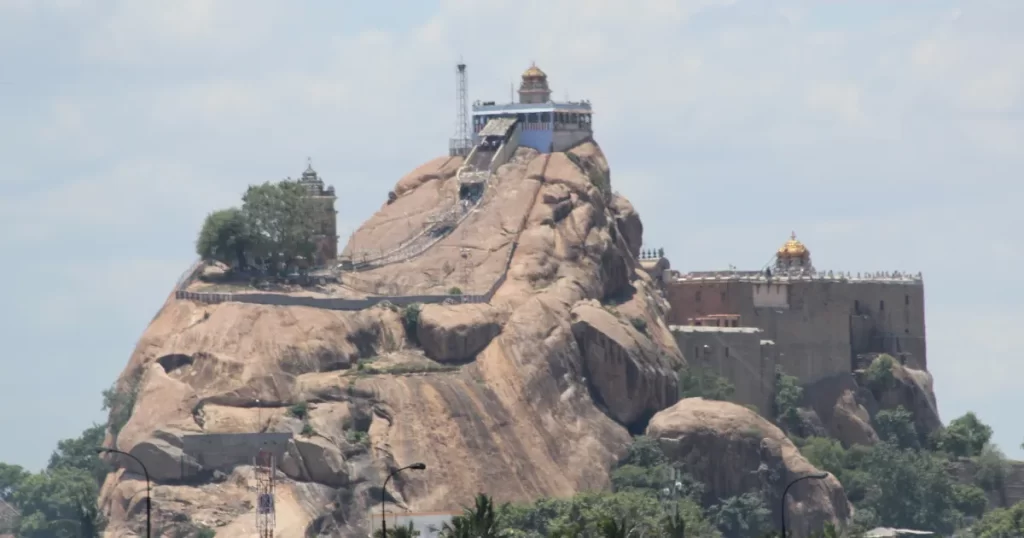
The Uchi Pillayar Temple, also known as the Rockfort Ganapathi Temple, is a historic Hindu temple dedicated to Lord Ganesh, located atop the Rockfort in Tiruchirapalli (Trichy), Tamil Nadu, India.
In the race for the top 15 ancient Ganesh temples in India 2025, The Uchi Pillayar Temple stands at the 6th position. Here is an overview of the Uchi Pillayar Temple:
- Location – The Uchi Pillayar Temple is situated on a massive rock formation known as the Rockfort, which rises abruptly to a height of around 83 meters in the heart of Tiruchirapalli city. It is located on the southern banks of the Kaveri River and offers panoramic views of the surrounding area.
- History – The Uchi Pillayar Temple has a long and storied history, dating back to ancient times. The temple is believed to have been built by the Pallava dynasty in the 7th century AD, although there are records indicating that it may have existed even earlier. The temple has undergone several renovations and expansions over the centuries.
- Deity – The presiding deity of the Uchi Pillayar Temple is Lord Ganesh, also known as Ucchi Pillayar or Rockfort Ganapathi. The idol of Lord Ganesh is enshrined within a cave temple located at the top of the Rockfort. The idol is believed to be a swayambhu (self-manifested) form of Lord Ganesh.
- Architecture – The temple’s architecture is a blend of ancient and Dravidian architectural styles. The entrance to the temple is adorned with a massive gopuram (entrance tower), and visitors have to climb over 400 steps carved into the rock to reach the sanctum sanctorum (garbhagriha) of the temple.
- Significance – The Uchi Pillayar Temple holds immense significance for devotees who seek the blessings of Lord Ganesh for success, prosperity, and the removal of obstacles. It is believed that worshipping Lord Ganesh at this temple can help devotees overcome challenges and achieve their goals.
- Rituals and Worship – The temple conducts regular rituals and prayers dedicated to Lord Ganesh, including elaborate poojas (worship ceremonies), abhishekams (ritualistic bathing), and aratis (offerings of light). Devotees offer prayers, flowers, coconuts, and other offerings to the deity as a mark of their devotion.
- Festivals – The Uchi Pillayar Temple celebrates various festivals dedicated to Lord Ganesh, with Vinayaka Chaturthi being the most prominent. During this festival, which usually falls in the month of August or September, the temple is adorned with decorations, and elaborate rituals and ceremonies are conducted.
- Visitor Information – The Uchi Pillayar Temple is open to devotees and visitors throughout the year. It is a popular pilgrimage destination in Tiruchirapalli and attracts devotees from different parts of Tamil Nadu and beyond.
Overall, the Uchi Pillayar Temple is a symbol of faith, devotion, and divine blessings in Tiruchirapalli and Tamil Nadu. It stands as a testament to the rich cultural and religious heritage of the region and continues to be a source of spiritual solace for devotees seeking the blessings of Lord Ganesh.
Ganpatipule Temple, Ratnagiri, Maharashtra
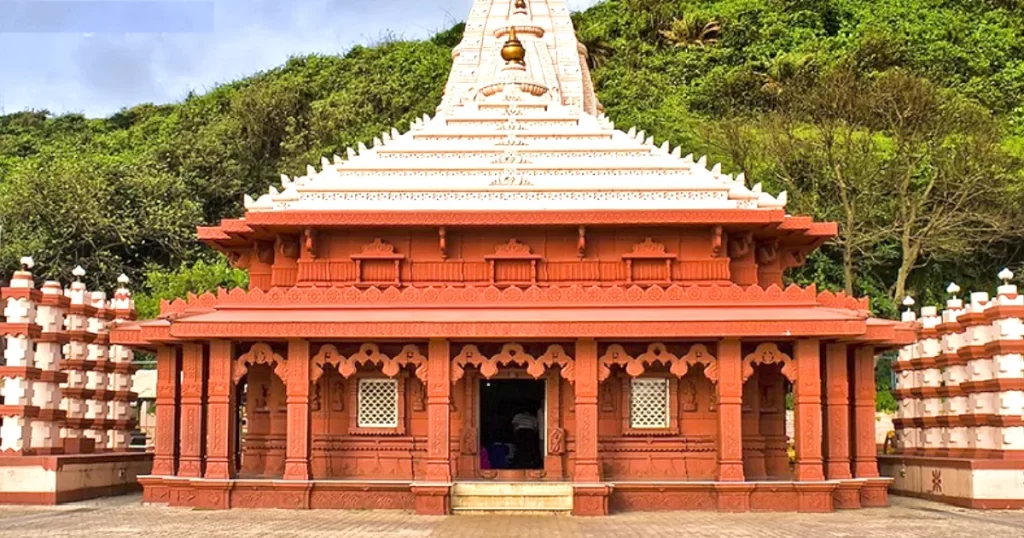
The Ganpatipule Temple is a prominent Hindu temple dedicated to Lord Ganesh, located in the town of Ganpatipule in the Ratnagiri district of Maharashtra, India. In the race for the top 15 ancient Ganesh temples in India 2025, The Ganpatipule Temple stands at the 7th position. Here is an overview of the Ganpatipule Temple:
- Location – The Ganpatipule Temple is situated along the Konkan coast, approximately 25 kilometers from Ratnagiri city. It is nestled amidst natural beauty, with the Arabian Sea on one side and lush green hills on the other, making it a popular pilgrimage destination and tourist attraction.
- History – The exact origins of the Ganpatipule Temple are not well-documented. However, it is believed to be an ancient temple with a rich history dating back several centuries. The temple has undergone renovations and expansions over the years and is now a prominent landmark in Ganpatipule.
- Deity – The presiding deity of the Ganpatipule Temple is Lord Ganesh, also known as Ganpati or Ganapati. The idol of Lord Ganesh is enshrined within the sanctum sanctorum (garbhagriha) of the temple and is worshipped with great reverence by devotees.
- Architecture – The temple’s architecture is simple yet elegant, reflecting traditional Konkan temple architecture. The main sanctum of the temple is adorned with sculptures depicting various forms of Lord Ganesh. The temple complex also includes other structures such as mandapams (pillared halls) and a water tank.
- Significance – The Ganpatipule Temple holds immense significance for devotees who seek the blessings of Lord Ganesh for success, prosperity, and the removal of obstacles. It is believed that worshipping Lord Ganesh at this temple can help devotees overcome challenges and achieve their goals.
- Rituals and Worship – The temple conducts regular rituals and prayers dedicated to Lord Ganesh, including elaborate poojas (worship ceremonies), abhishekams (ritualistic bathing), and aratis (offerings of light). Devotees offer prayers, flowers, coconuts, and other offerings to the deity as a mark of their devotion.
- Festivals – The Ganpatipule Temple celebrates various festivals dedicated to Lord Ganesh, with Ganesh Chaturthi being the most prominent. During this festival, which usually falls in the month of August or September, the temple is adorned with decorations, and elaborate rituals and ceremonies are conducted.
- Visitor Information – The Ganpatipule Temple is open to devotees and visitors throughout the year. It is a popular pilgrimage destination and tourist spot in Maharashtra and attracts devotees and tourists from different parts of the state and beyond.
Overall, the Ganpatipule Temple is a sacred place of worship and a symbol of faith and devotion in Ganpatipule and Maharashtra. It stands as a testament to the rich cultural and religious heritage of the region and continues to be a source of spiritual solace for devotees seeking the blessings of Lord Ganesh.
Varasiddhi Vinayaka Temple, Kanipakam, Andhra Pradesh
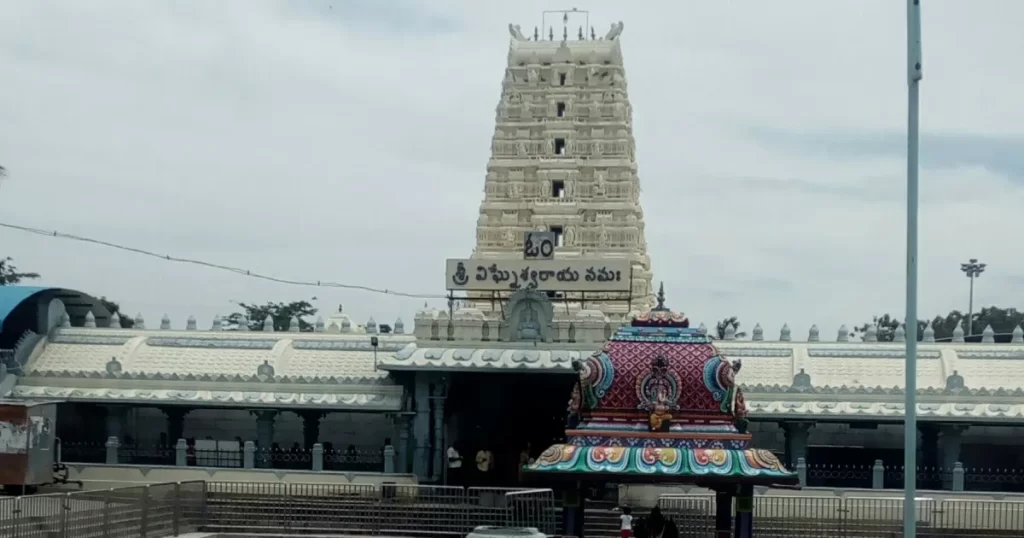
The Varasiddhi Vinayaka Temple is a famous Hindu temple dedicated to Lord Ganesh, located in the village of Kanipakam in Chittoor district, Andhra Pradesh, India. In the race for the top 15 ancient Ganesh temples in India 2025, The Varasiddhi Vinayaka Temple stands at the 8th position. Here is an overview of the Varasiddhi Vinayaka Temple:
- Location – The Varasiddhi Vinayaka Temple is situated in Kanipakam, a village located approximately 11 kilometers from the town of Chittoor in Andhra Pradesh. It is easily accessible by road and is a popular pilgrimage destination in the region.
- History – The exact origins of the Varasiddhi Vinayaka Temple are not well-documented. However, the temple is believed to have been built during the Vijayanagara Empire period, making it several centuries old. The temple has a rich history and is considered a sacred site by devotees.
- Deity – The presiding deity of the Varasiddhi Vinayaka Temple is Lord Ganesh, also known as Varasiddhi Vinayaka. The idol of Lord Ganesh is enshrined within the sanctum sanctorum (garbhagriha) of the temple and is worshipped with great reverence by devotees.
- Architecture – The temple’s architecture is simple yet elegant, reflecting traditional South Indian temple architecture. The main sanctum of the temple is adorned with sculptures depicting various forms of Lord Ganesh. The temple complex also includes other structures such as mandapams (pillared halls) and a water tank.
- Significance – The Varasiddhi Vinayaka Temple holds immense significance for devotees who seek the blessings of Lord Ganesh for success, prosperity, and the removal of obstacles. It is believed that worshipping Lord Ganesh at this temple can help devotees overcome challenges and achieve their goals.
- Rituals and Worship – The temple conducts regular rituals and prayers dedicated to Lord Ganesh, including elaborate poojas (worship ceremonies), abhishekams (ritualistic bathing), and aratis (offerings of light). Devotees offer prayers, flowers, coconuts, and other offerings to the deity as a mark of their devotion.
- Festivals – The Varasiddhi Vinayaka Temple celebrates various festivals dedicated to Lord Ganesh, with Vinayaka Chaturthi being the most prominent. During this festival, which usually falls in the month of August or September, the temple is adorned with decorations, and elaborate rituals and ceremonies are conducted.
- Visitor Information – The Varasiddhi Vinayaka Temple is open to devotees and visitors throughout the year. It is a popular pilgrimage destination in Andhra Pradesh and attracts devotees from different parts of the state and beyond.
Overall, the Varasiddhi Vinayaka Temple is a sacred place of worship and a symbol of faith and devotion in Kanipakam and Andhra Pradesh. It stands as a testament to the rich cultural and religious heritage of the region and continues to be a source of spiritual solace for devotees seeking the blessings of Lord Ganesh.
Manakula Vinayagar Temple, Pondicherry
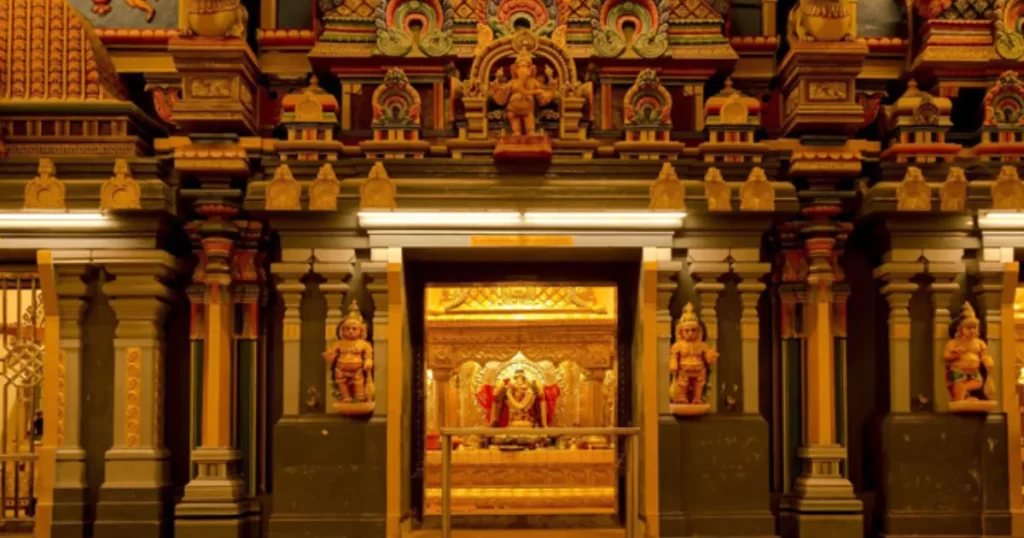
The Manakula Vinayagar Temple is a popular Hindu temple dedicated to Lord Ganesh, located in the Union Territory of Pondicherry (Puducherry), India. In the race for the top 15 ancient Ganesh temples in India 2025, The Manakula Vinayagar Temple stands at the 9th position. Here is an overview of the Manakula Vinayagar Temple:
- Location – The Manakula Vinayagar Temple is situated in the heart of Pondicherry, near the White Town area. It is easily accessible from different parts of the city and is a prominent landmark in Pondicherry.
- History – The exact origins of the Manakula Vinayagar Temple are not well-documented. However, the temple is believed to have a history dating back several centuries. It has undergone renovations and expansions over the years and is considered a sacred site by devotees.
- Deity – The presiding deity of the Manakula Vinayagar Temple is Lord Ganesh, also known as Manakula Vinayagar. The idol of Lord Ganesh is enshrined within the sanctum sanctorum (garbhagriha) of the temple and is worshipped with great reverence by devotees.
- Architecture – The temple’s architecture is a blend of traditional South Indian temple architecture and French colonial influences. The main sanctum of the temple is adorned with sculptures depicting various forms of Lord Ganesh. The temple complex also includes other structures such as mandapams (pillared halls) and a water tank.
- Significance – The Manakula Vinayagar Temple holds immense significance for devotees who seek the blessings of Lord Ganesh for success, prosperity, and the removal of obstacles. It is believed that worshipping Lord Ganesh at this temple can help devotees overcome challenges and achieve their goals.
- Rituals and Worship – The temple conducts regular rituals and prayers dedicated to Lord Ganesh, including elaborate poojas (worship ceremonies), abhishekams (ritualistic bathing), and aratis (offerings of light). Devotees offer prayers, flowers, coconuts, and other offerings to the deity as a mark of their devotion.
- Festivals – The Manakula Vinayagar Temple celebrates various festivals dedicated to Lord Ganesh, with Vinayaka Chaturthi being the most prominent. During this festival, which usually falls in the month of August or September, the temple is adorned with decorations, and elaborate rituals and ceremonies are conducted.
- Visitor Information – The Manakula Vinayagar Temple is open to devotees and visitors throughout the year. It is a popular pilgrimage destination in Pondicherry and attracts devotees from different parts of the union territory and beyond.
Overall, the Manakula Vinayagar Temple is a sacred place of worship and a symbol of faith and devotion in Pondicherry. It stands as a testament to the rich cultural and religious heritage of the region and continues to be a source of spiritual solace for devotees seeking the blessings of Lord Ganesh.
Kudalasangama Ganapathi Temple, Bagalkot, Karnataka
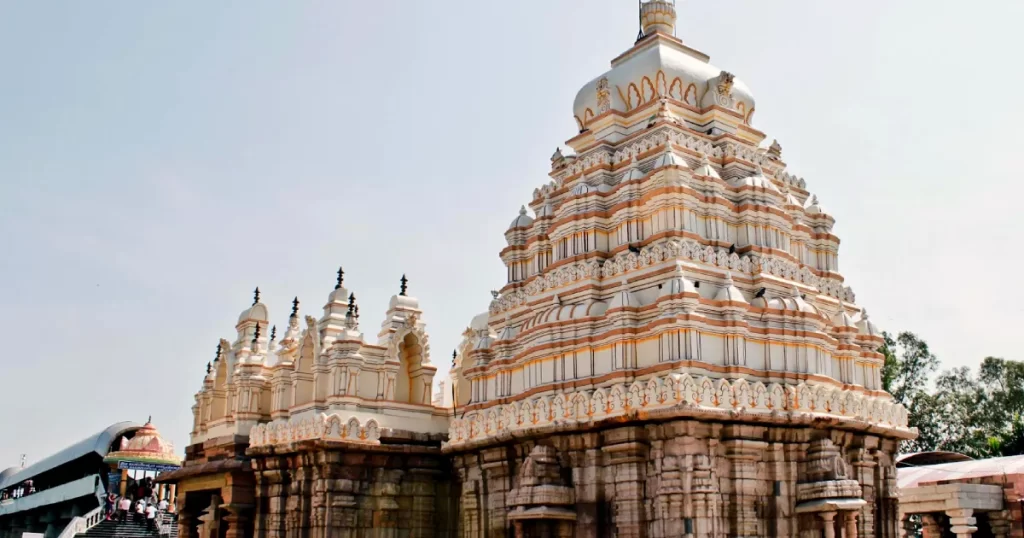
The Kudalasangama Ganapathi Temple is indeed a well-known temple located in Kudalasangama, Bagalkot district, Karnataka, India. In the race for the top 15 ancient Ganesh temples in India 2025, The Kudalasangama Ganapathi Temple stands at the 10th position. Here is some information about the Kudalasangama Ganapathi Temple:
- Location – The Kudalasangama Ganapathi Temple is situated in Kudalasangama, a pilgrimage town located at the confluence of the Krishna and Malaprabha rivers in the Bagalkot district of Karnataka.
- Deity – The presiding deity of the Kudalasangama Ganapathi Temple is Lord Ganesh, also known as Ganapathi or Vinayaka. The temple is dedicated to Lord Ganesh, who is worshipped with great reverence by devotees.
- Significance – The Kudalasangama Ganapathi Temple holds immense significance for devotees who seek the blessings of Lord Ganesh for success, prosperity, and the removal of obstacles. It is believed that worshipping Lord Ganesh at this temple can help devotees overcome challenges and achieve their goals.
- Architecture – The temple’s architecture is a blend of traditional South Indian temple architecture. The main sanctum of the temple is adorned with sculptures depicting various forms of Lord Ganesh. The temple complex also includes other structures such as mandapams (pillared halls) and a water tank.
- Rituals and Worship – The temple conducts regular rituals and prayers dedicated to Lord Ganesh, including elaborate poojas (worship ceremonies), abhishekams (ritualistic bathing), and aratis (offerings of light). Devotees offer prayers, flowers, coconuts, and other offerings to the deity as a mark of their devotion.
- Festivals – The Kudalasangama Ganapathi Temple celebrates various festivals dedicated to Lord Ganesh, with Vinayaka Chaturthi being the most prominent. During this festival, which usually falls in the month of August or September, the temple is adorned with decorations, and elaborate rituals and ceremonies are conducted.
- Visitor Information – The Kudalasangama Ganapathi Temple is open to devotees and visitors throughout the year. It is a popular pilgrimage destination in Karnataka and attracts devotees from different parts of the state and beyond.
Overall, the Kudalasangama Ganapathi Temple is a sacred place of worship and a symbol of faith and devotion in Kudalasangama and Karnataka. It stands as a testament to the rich cultural and religious heritage of the region and continues to be a source of spiritual solace for devotees seeking the blessings of Lord Ganesh.
Kanipakam Vinayaka Temple, Chittoor, Andhra Pradesh
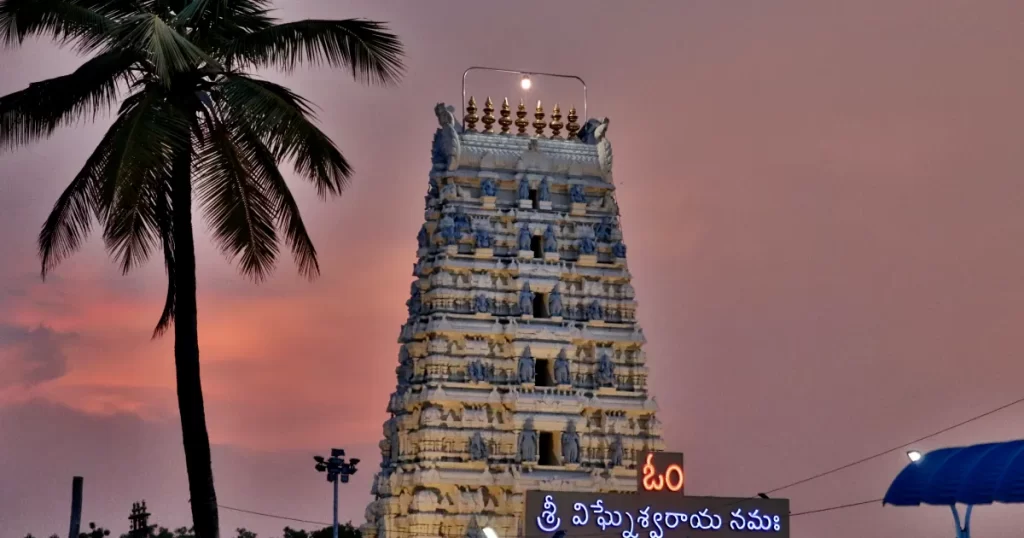
The Kanipakam Vinayaka Temple is a revered Hindu temple dedicated to Lord Ganesh, located in the village of Kanipakam in the Chittoor district of Andhra Pradesh, India. In the race for the top 15 ancient Ganesh temples in India 2025, The Kanipakam Vinayaka Temple stands at the 11th position. Here is some information about the Kanipakam Vinayaka Temple:
- Location – The Kanipakam Vinayaka Temple is situated in Kanipakam, a village located approximately 11 kilometers from the town of Chittoor in Andhra Pradesh. It is easily accessible by road and is a popular pilgrimage destination in the region.
- History – The temple has a rich history dating back several centuries. It is believed to have been constructed during the Chola dynasty rule in the region. The temple has undergone renovations and expansions over the years and is considered a sacred site by devotees.
- Deity – The presiding deity of the Kanipakam Vinayaka Temple is Lord Ganesh, also known as Kanipakam Vinayaka. The idol of Lord Ganesh is enshrined within the sanctum sanctorum (garbhagriha) of the temple and is worshipped with great reverence by devotees.
- Architecture – The temple’s architecture is simple yet elegant, reflecting traditional South Indian temple architecture. The main sanctum of the temple is adorned with sculptures depicting various forms of Lord Ganesh. The temple complex also includes other structures such as mandapams (pillared halls) and a water tank.
- Significance – The Kanipakam Vinayaka Temple holds immense significance for devotees who seek the blessings of Lord Ganesh for success, prosperity, and the removal of obstacles. It is believed that worshipping Lord Ganesh at this temple can help devotees overcome challenges and achieve their goals.
- Rituals and Worship – The temple conducts regular rituals and prayers dedicated to Lord Ganesh, including elaborate poojas (worship ceremonies), abhishekams (ritualistic bathing), and aratis (offerings of light). Devotees offer prayers, flowers, coconuts, and other offerings to the deity as a mark of their devotion.
- Festivals – The Kanipakam Vinayaka Temple celebrates various festivals dedicated to Lord Ganesh, with Vinayaka Chaturthi being the most prominent. During this festival, which usually falls in the month of August or September, the temple is adorned with decorations, and elaborate rituals and ceremonies are conducted.
- Visitor Information – The Kanipakam Vinayaka Temple is open to devotees and visitors throughout the year. It is a popular pilgrimage destination in Andhra Pradesh and attracts devotees from different parts of the state and beyond.
Overall, the Kanipakam Vinayaka Temple is a sacred place of worship and a symbol of faith and devotion in Kanipakam and Andhra Pradesh. It stands as a testament to the rich cultural and religious heritage of the region and continues to be a source of spiritual solace for devotees seeking the blessings of Lord Ganesh.
Shree Siddhivinayak Temple, Nashik, Maharashtra
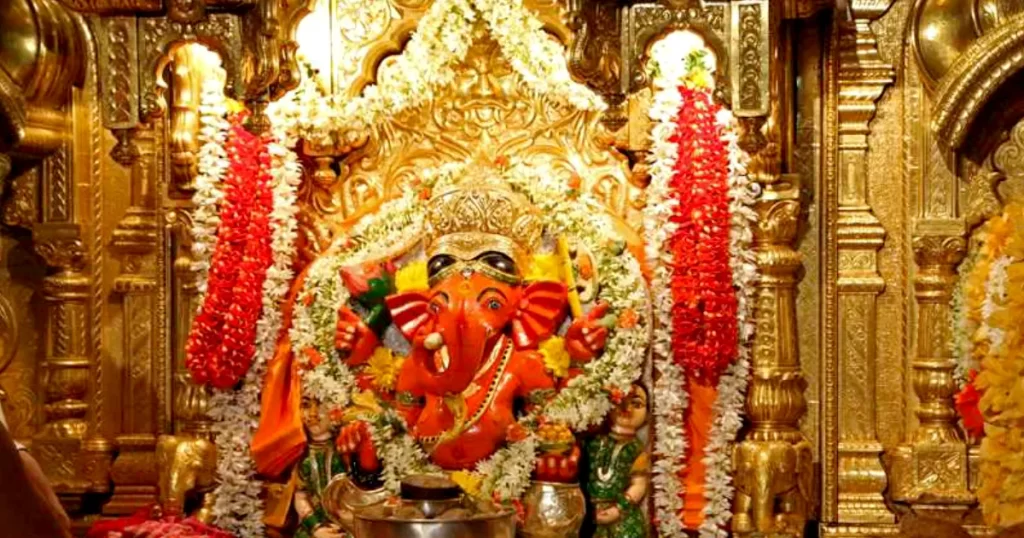
The Shree Siddhivinayak Temple in Nashik, Maharashtra, is a popular Hindu temple dedicated to Lord Ganesh, also known as Siddhivinayak. In the race for the top 15 ancient Ganesh temples in India 2025, The Shree Siddhivinayak Temple in Nashik stands at the 12th position. Here is some information about the Shree Siddhivinayak Temple in Nashik:
- Location – The Shree Siddhivinayak Temple is located in the city of Nashik, which is situated in the Nashik district of Maharashtra, India. Nashik is known for its religious significance and is one of the important pilgrimage sites in the state.
- Deity – The presiding deity of the Shree Siddhivinayak Temple is Lord Ganesh, the remover of obstacles and the god of wisdom and prosperity. Lord Ganesh is worshipped with great devotion by Hindus, and the temple serves as a place of prayer and reverence for devotees seeking his blessings.
- Architecture – The architecture of the Shree Siddhivinayak Temple reflects traditional Hindu temple architecture prevalent in Maharashtra. While specific details about the temple’s architecture may vary, it typically features a sanctum sanctorum (garbhagriha) where the idol of Lord Ganesh is enshrined, along with other structures such as a mandapam (pillared hall) and a flagstaff (dhvajastambha).
- Significance – The Shree Siddhivinayak Temple holds immense significance for devotees who seek the blessings of Lord Ganesh for success, prosperity, and the removal of obstacles in their lives. It is a place where devotees come to offer prayers, perform rituals, and seek divine intervention to overcome challenges and fulfill their wishes.
- Rituals and Worship – The temple conducts regular rituals and prayers dedicated to Lord Ganesh, including daily poojas (worship ceremonies), abhishekams (ritualistic bathing), and aratis (offerings of light). Devotees offer various items such as flowers, coconuts, fruits, and sweets to the deity as part of their worship.
- Festivals – The Shree Siddhivinayak Temple celebrates various festivals dedicated to Lord Ganesh, with Ganesh Chaturthi being the most prominent. During this festival, which usually falls in the month of August or September, the temple is adorned with decorations, and elaborate rituals and ceremonies are conducted to honor the deity.
- Visitor Information – The Shree Siddhivinayak Temple in Nashik is open to devotees and visitors throughout the year. It welcomes people from different parts of Maharashtra and beyond who come to seek the blessings of Lord Ganesh and experience the spiritual ambiance of the temple.
Overall, the Shree Siddhivinayak Temple in Nashik is a sacred place of worship and a symbol of faith and devotion for the local community and devotees. It stands as a testament to the rich religious heritage of Maharashtra and continues to be a source of spiritual solace and inspiration for all who visit it
Ganesha Temple, Neur, Goa
The Ganesha Temple in Neur, Goa, is a Hindu temple dedicated to Lord Ganesh, also known as Ganesha. In the race for the top 15 ancient Ganesh temples in India 2025, The Ganesha Temple, Neur, Goa stands at the 13th position. Here is some information about the Ganesha Temple in Neur, Goa:
- Location – The Ganesha Temple is located in the village of Neur, which is situated in the Ponda taluka of North Goa district, Goa, India. Neur is known for its religious significance and is home to several temples dedicated to various Hindu deities.
- Deity – The presiding deity of the Ganesha Temple is Lord Ganesh, the remover of obstacles and the god of wisdom and prosperity. Lord Ganesh is worshipped with great devotion by Hindus, and the temple serves as a place of prayer and reverence for devotees seeking his blessings.
- Architecture – The architecture of the Ganesha Temple in Neur reflects traditional Goan temple architecture. While specific details about the temple’s architecture may vary, it typically features a sanctum sanctorum (garbhagriha) where the idol of Lord Ganesh is enshrined, along with other structures such as a mandapam (pillared hall) and a flagstaff (dhvajastambha).
- Significance – The Ganesha Temple holds immense significance for devotees who seek the blessings of Lord Ganesh for success, prosperity, and the removal of obstacles in their lives. It is a place where devotees come to offer prayers, perform rituals, and seek divine intervention to overcome challenges and fulfill their wishes.
- Rituals and Worship – The temple conducts regular rituals and prayers dedicated to Lord Ganesh, including daily poojas (worship ceremonies), abhishekams (ritualistic bathing), and aratis (offerings of light). Devotees offer various items such as flowers, coconuts, fruits, and sweets to the deity as part of their worship.
- Festivals – The Ganesha Temple celebrates various festivals dedicated to Lord Ganesh, with Ganesh Chaturthi being the most prominent. During this festival, which usually falls in the month of August or September, the temple is adorned with decorations, and elaborate rituals and ceremonies are conducted to honor the deity.
- Visitor Information – The Ganesha Temple in Neur is open to devotees and visitors throughout the year. It welcomes people from different parts of Goa and beyond who come to seek the blessings of Lord Ganesh and experience the spiritual ambiance of the temple.
Overall, the Ganesha Temple in Neur, Goa, is a sacred place of worship and a symbol of faith and devotion for the local community and devotees. It stands as a testament to the rich religious heritage of Goa and continues to be a source of spiritual solace and inspiration for all who visit it.
Ganesh Tok Temple, Gangtok, Sikkim
The Ganesh Tok Temple is a Hindu temple dedicated to Lord Ganesh, located in Gangtok, the capital city of Sikkim, India. In the race for the top 15 ancient Ganesh temples in India 2025, The Ganesh Tok Temple, Gangtok, Sikkim stands at the 14th position. Here is some information about the Ganesh Tok Temple:
- Location – The Ganesh Tok Temple is situated atop a hill, approximately 7 kilometers from Gangtok city center. It offers panoramic views of the surrounding hills and the city of Gangtok.
- Deity – The presiding deity of the Ganesh Tok Temple is Lord Ganesh, the remover of obstacles and the god of wisdom and prosperity. Lord Ganesh is worshipped with great devotion by Hindus, and the temple serves as a place of prayer and reverence for devotees seeking his blessings.
- Architecture – The architecture of the Ganesh Tok Temple is simple yet elegant, reflecting the traditional style of temple architecture found in the region. The temple is relatively small in size but is adorned with colorful decorations and sculptures depicting Lord Ganesh.
- Significance – The Ganesh Tok Temple holds immense significance for devotees who seek the blessings of Lord Ganesh for success, prosperity, and the removal of obstacles in their lives. It is believed that worshipping Lord Ganesh at this temple can help devotees overcome challenges and achieve their goals.
- Rituals and Worship – The temple conducts regular rituals and prayers dedicated to Lord Ganesh, including daily poojas (worship ceremonies), abhishekams (ritualistic bathing), and aratis (offerings of light). Devotees offer various items such as flowers, coconuts, fruits, and sweets to the deity as part of their worship.
- Festivals – The Ganesh Tok Temple celebrates various festivals dedicated to Lord Ganesh, with Ganesh Chaturthi being the most prominent. During this festival, which usually falls in the month of August or September, the temple is adorned with decorations, and elaborate rituals and ceremonies are conducted to honor the deity.
- Visitor Information – The Ganesh Tok Temple is open to devotees and visitors throughout the year. It is a popular tourist attraction in Gangtok and attracts people from different parts of Sikkim and beyond who come to seek the blessings of Lord Ganesh and enjoy the scenic beauty of the surrounding area.
Overall, the Ganesh Tok Temple in Gangtok, Sikkim, is a sacred place of worship and a symbol of faith and devotion for the local community and devotees. It stands as a testament to the rich religious heritage of Sikkim and continues to be a source of spiritual solace and inspiration for all who visit it.
Shree Karpaga Vinayagar Temple, Pillayarpatti, Tamil Nadu
The Shree Karpaga Vinayagar Temple, located in Pillayarpatti, Tamil Nadu, is a renowned Hindu temple dedicated to Lord Ganesha, also known as Vinayagar in South India. The temple is believed to have been built during the Pandya dynasty rule in the region, making it over a thousand years old.
It is one of the oldest and most significant Ganesha temples in Tamil Nadu. In the race for the top 15 ancient Ganesh temples in India 2025, The Shree Karpaga Vinayagar Temple, Pillayarpatti, Tamil Nadu stands at the 15th position.
Here are some key features and aspects of the Shree Karpaga Vinayagar Temple:
- Architecture – The temple’s architecture is a blend of Chola and Pandya styles, reflecting the cultural heritage of the region. The outer structure of the temple showcases intricate carvings and sculptures, depicting various mythological stories and figures.
- Main Deity – The primary deity of the temple is Lord Karpaga Vinayagar, an incarnation of Lord Ganesha. The idol of Lord Karpaga Vinayagar is believed to be self-manifested (Swayambhu), carved out of a single stone. It is one of the largest Ganesha idols in South India, standing at about 6 feet tall.
- Significance – The temple holds immense significance for devotees of Lord Ganesha, who visit to seek his blessings for success, prosperity, and the removal of obstacles (Vighna). It is particularly revered by those who are starting new ventures or seeking solutions to their problems.
- Festivals – Various festivals are celebrated with grandeur at the Shree Karpaga Vinayagar Temple, including Vinayaka Chaturthi, Navaratri, and Panguni Uthiram. These festivals attract a large number of devotees from across the region and beyond.
- Pillayarpatti Cave Temple – Adjacent to the main temple, there is a cave temple dedicated to Lord Murugan, another prominent deity in Hinduism. This cave temple also features intricate carvings and sculptures.
- Location – The Shree Karpaga Vinayagar Temple is situated in the town of Pillayarpatti, which is approximately 12 kilometers from Karaikudi in the Sivaganga district of Tamil Nadu. It is easily accessible by road.
- Devotee Amenities – The temple complex provides various amenities for devotees, including accommodation facilities, dining halls (Annadhanam), and spaces for meditation and prayer.
Overall, the Shree Karpaga Vinayagar Temple in Pillayarpatti is not only a place of worship but also a symbol of cultural and historical significance in Tamil Nadu. It continues to attract devotees and visitors from different parts of India and the world, seeking spiritual solace and blessings from the revered deity, Lord Karpaga Vinayagar.
All Other Important Ganesh Temples in India
- Chintaman Ganesh Temple, Ujjain, Madhya Pradesh
- Shree Vighnahar Ganapati Temple, Ozar, Maharashtra
- Shree Vajreshwari Temple, Kangra, Himachal Pradesh
- Ganesha Temple, Prabhadevi, Mumbai, Maharashtra
- Moreshwar Ganpati Temple, Morgaon, Maharashtra
- Shree Mayureshwar Mandir, Morgaon, Maharashtra
- Swayambhoo Ganpati Temple, Swayambhu, Maharashtra
- Shree Siddhivinayak Temple, Siddhatek, Maharashtra
- Shree Varad Vinayak Temple, Mahad, Maharashtra
- Shree Vighneshwar Vinayak Temple, Ozar, Maharashtra
- Shree Mahaganapati Temple, Ranjangaon, Maharashtra
- Shree Mahaganapati Temple, Adur, Maharashtra
- Shree Mayureshwar Temple, Morachi Chincholi, Maharashtra
- Shree Vighnahar Ganapati Temple, Ozar, Maharashtra
- Shree Ballaleshwar Ganpati Temple, Pali, Maharashtra
- Shree Girijatmaj Ganpati Temple, Lenyadri, Maharashtra
- Shree Chintamani Ganpati Temple, Theur, Maharashtra
- Shree Siddhivinayak Temple, Titwala, Maharashtra
- Ganesha Ratha Temple, Mamallapuram, Tamil Nadu
- Ganesha Temple, Kozhikode, Kerala
Please note that this list is not exhaustive, and there are many more Ganesh temples across India, each with its own unique significance and history.

